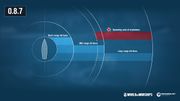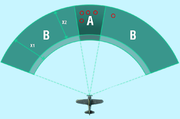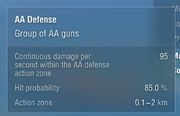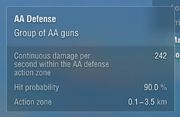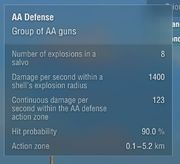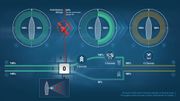Anti-Aircraft Fire
| Revision as of 18:59, 28 September 2019 → Sector Reinforcement Note the effect of Massive AA Fire | Revision as of 20:48, 29 September 2019 __NOEDITSECTION__ | |||
| Line 5: | Line 5: | |||
| {{block|!!|content= '''N.b''' that some details shown in the How It Works video are out of date, particularly with regard to how AA defenses operate. The pictures and basic concepts are still good. Read the text below for up to date information.}} | {{block|!!|content= '''N.b''' that some details shown in the How It Works video are out of date, particularly with regard to how AA defenses operate. The pictures and basic concepts are still good. Read the text below for up to date information.}} | |||
| ? | + | __TOC____NOEDITSECTION__ | ||
| Like ships, every plane in ''World of Warships'' possesses a certain number of hit or health points (HP). (Carrier-based aircraft HP ranges roughly 1500-2400.) In order to shoot down a plane, this health pool must be reduced to zero. A surface ship can do that with its AA guns and, in some cases, with its fighters. We'll start with how AA guns are implemented. | Like ships, every plane in ''World of Warships'' possesses a certain number of hit or health points (HP). (Carrier-based aircraft HP ranges roughly 1500-2400.) In order to shoot down a plane, this health pool must be reduced to zero. A surface ship can do that with its AA guns and, in some cases, with its fighters. We'll start with how AA guns are implemented. | |||
Revision as of 20:48, 29 September 2019
N.b that some details shown in the How It Works video are out of date, particularly with regard to how AA defenses operate. The pictures and basic concepts are still good. Read the text below for up to date information.
Contents
Like ships, every plane in World of Warships possesses a certain number of hit or health points (HP). (Carrier-based aircraft HP ranges roughly 1500-2400.) In order to shoot down a plane, this health pool must be reduced to zero. A surface ship can do that with its AA guns and, in some cases, with its fighters. We'll start with how AA guns are implemented.
Anti-Aircraft Guns
Guns that are useful against attacking aircraft are generally grouped into three classes by range and effect, both functions of caliber.[1]
Short Range Guns
28mm or smaller caliber. Essentially, these are machine guns. Small, light, fast-firing guns that usually throw solid shells (with a few tracer rounds mixed in). The small shells aren't able to retain enough energy to be effective (or aimable) beyond 2km. But the high volume of fire can make them dangerous within that range. Small caliber AA guns can be single-mounted nearly anywhere on the ship or they can be clustered in mounts with up to 8 barrels and relatively sophisticated aiming mechanisms. An example of the single mount is the ubiquitous ".50 Cal" Browning machine gun. (12.7mm caliber)
Medium Range Guns
28.1 to 85mm caliber (1.1" to 3.5"). These are serious guns, with shell weights from 1 to 9kg. These calibers are perfect for the anti-air role as they have good range, respectable rates of fire, and hits do significant damage even against relatively large aircraft. The larger guns can fire proximity fused shells; the smaller are light enough to mount on nearly any ship. An example of the medium range AA gun is the 40mm Bofors, often quad-mounted, which is considered to be the most effective anti-air weapon of WWII.
Long Range Guns
Greater than 85mm caliber (3.5" and up). Large calibers with much slower rates of fire than the smaller classes, but with long effective range and altitude and a large warhead. These guns are similar to - and often were - secondary anti-surface, or dual-purpose guns. Especially later in WWII, even main batteries were modified to perform as dual-purpose weapons, e.g. 155mm (6") and 203mm (8")[2] USN cruiser mounts. More common in the AA role were the USN's 127mm (5") twin mounts.
For AA use, the shells often carry explosive warheads designed to throw out a sphere of deadly shrapnel so that just getting a shell close to an aircraft might kill it.
Anti-Aircraft Auras
Unlike anti-ship artillery or torpedo armament, World of Warships does not plot fields of fire or calculate trajectories for anti-aircraft guns. With the large number of AA guns and high rates of fire, doing so would place an unacceptable load on the servers. Instead, anti-aircraft armament is collected into three zones of effect — auras — divided by the three gun classes described above. The auras overlap and reinforce each other.
Auras start at 100m from the ship. The depth of each aura is defined by the types of guns that form it: a ship with X type gun may have an aura with maximum range (depth) 2.5km, while on a ship with Y type gun the depth of the same aura may be only 1.9km. The auras do have minimum depths.
The three auras are short range - guns up to and including calibers of 28mm, depth >1.5km; medium range - guns of caliber 28.1 to 85mm, depth >2.5km; long range - the big rifles over 85mm, depth >4km.[3]
Like secondary batteries, AA guns begin a battle unloaded and start to load as soon as an enemy plane enters the outer aura. Thus, for the very first air attack on your ship, AA may not inflict damage immediately. (This mechanic may change in the future.)
Continuous Damage
Every AA mount can do damage to attacking planes. Grouped by gun class into an aura, this damage is applied as continuous damage. Continuous damage has two parts: a maximum damage done, and a percent chance that it is done.[4] The maximum damage and hit rate are determined by the numbers and types of guns comprising the aura. For example, a short range aura that can do 100 damage with a to-hit rate of 90%: Each second that an airplane remains within the aura, the system applies, on average, (100 * 90%) or 90 damage to it.[5]
But the squadron doesn't get off that easily. In the case of the short range aura, both the medium and long range auras overlap it. Continuous damage from all three auras is applied independently to a squadron within ~2 km of the ship.
If several planes or squadrons are within an aura, continuous damage at full current strength is applied to each of them.
If the auras from two or more ships overlap, the resulting continuous damage is not the sum of them, but a lesser amount using an unspecified formula.[6]
Continuous damage is applied to the last plane in the squadron.[7]
For instantaneous damage, see Sector Reinforcement below.
Flak
Long-range guns[8] cover a flak zone between the maximum range of the big guns and 3.5 km from the ship. Into this zone they can throw shells that explode in deadly bursts of shrapnel. These explosions are modeled as flak bursts or flak clouds. If an aircraft flies into a flak cloud, the shrapnel does a large amount of damage (roughly 1000-2000 HP per second).[9] Few carrier-based aircraft can enter two clouds and survive. However, since these clouds only damage those planes that fly through them, they are ineffective against skilled pilots who manage to dodge.
The number of flak bursts depends on the guns and modifications.[10] The size or radius of a burst scales up with caliber. For example, the flak bursts from a Massachusetts, which are generated by 127mm guns, are larger than those of a Roma, which relies on 90mm guns. Flak guns reload and throw up new flak clouds every 2 seconds. (By the time they appear older clouds have dissipated.)
The air defense fire directors try to place shells in the path of the incoming squadron. From the speed and current course of the squadron, they calculate a target zone (zone A in the accompanying illustration). The depths of zone (marked x1 and x2) depend on the speed of the aircraft, and are smaller for slower planes. Most of the flak bursts will appear in the target zone, but some shells will miss and explode nearby (zone B).
From a single ship against a single squadron, 80% of the shells, to a maximum of six, explode in zone A, the rest in zone B. If there are multiple squadrons in the flak zone (and thus more than one target zone A), the guns generate the same number of bursts, and the bursts are distributed among the A zones.
When more than one ship engages the squadron, the number of flak clouds in the target zone can nearly double. In this event, the most powerful flak bursts are prioritized to appear in Zone A.[11]
Damage from flak is not applied at the squadron level, but to the individual plane that enters the volume of a burst. A single large burst might damage multiple planes. Flak bursts do not overlap.
Note that not all ships have long range AA guns. These ships have no long range aura and cannot generate flak.
An Example - Prinz Eugen
Here we illustrate air defense operations using the characteristics of the German Tier 8 Premium Cruiser Prinz Eugen.
Short Range Aura
Prinz Eugen carries 28x 20 mm Flakzwilling 38 barrels in dual and quad mounts. Her short range aura has effect at ranges between 0.1 and 2km. Within that hemisphere, the short-range 20mm guns may deal up to 95 damage to aircraft every second. This damage is not guaranteed; the hit percentage is 85%. This means that every second there is an 85% chance that 95 damage is done to the intruder.
Note that the medium- and long-range auras overlap the short-range aura, so within it the overall damage per second in much higher — up to 460 HP.
Medium Range Aura
Prinz Eugen's medium range aura is active out to 3.5km. As with the short range aura, there is a 90% chance every second that her eighteen 40 mm L/56 Flak 28 mounts will do 242 damage.[8]
Long Range Aura and Flak
Prinz Eugen's long-range artillery is 6x2 105 mm L/65 Dop. L. C/31. These are effective out to 5.2km. The big 105mm guns can do 123 continuous damage with a hit rate of 90% (110 HP average).
In addition, they throw up eight flak bursts every two seconds in front of the attacking squadron. (Normally six bursts, but our example ship has the AA Modification 1 upgrade.) A plane that flies into a cloud must absorb 1400 damage per second - almost enough to kill a smaller carrier plane. The flak tracks inward until the attacking squadron gets closer than 3.5km to the ship.
Sector Reinforcement
Every ship has the ability to focus the AA firepower on one side of the ship, which correspondingly weakens the other side. Pointing the camera toward the incoming planes and pressing '~' (tilde) or the letter 'O' key activates a priority AA sector on either the port or the starboard side of the ship (preferably the side that aircraft are attacking).
Activating a priority sector has two effects: First, an amount of damage is immediately applied to all enemy squadrons within the sector. Second, the continuous damage from the auras gradually[12] increases on the priority side and correspondingly decreases on the other side. Sector reinforcement has no effect on flak bursts.
Instantaneous damage
Instantaneous damage, expressed as a percent of the entire squadron's HP, is applied to the squadron immediately on activation of a priority sector. (Prinz Eugen, as a cruiser, applies base 3.5%.) That amount is applied to the last plane(s) in the squadron. If there is no squadron within an AA aura when sector reinforcement is activated, no instantaneous damage is done.[13]
Continuous damage shift
Each ship type has a duration over which the continuous damage is shifted toward the incoming attacker. In the case of a cruiser, the shift takes approximately half the 10 second reinforcement duration. The maximum effect is a 150% increase in continuous damage. Then the effect returns to normal and there is a base 10 second cooldown period (preparation time) before sector reinforcement can be activated again.
There is a level of skill in timing the use of sector reinforcement. Activate it too early - while the attacker is outside the outer aura - and no instantaneous damage will be done. Activate it too late and the squadron may get its attack off and escape before the continuous damage can increase significantly. The faster the attacker, the more important this timing becomes.[14] For this reason, enabling the AA range circle on the minimap is highly recommended.
The table below shows how priority sector action varies by ship type.
| Ship Type | Instant. Dmg | Ramp-up time | Max. Reinforcement | Reinforce Time | Cooldown |
|---|---|---|---|---|---|
| Destroyer | 5% | ~5 sec | 135% | 10 sec | 10 sec |
| Cruiser | 3.5% | ~5 sec | 150% | 10 sec | 10 sec |
| Battleship | 3.5% | ~5 sec | 135% | 15 sec | 15 sec |
| Aircraft Carrier | 3.0% | ~5 sec | 135% | 15 sec | 5 sec |
Massive AA Fire
The Massive AA Fire commander skill has a pronounced effect on a reinforced sector, doubling instantaneous damage while stretching out the cooldown time. It also makes an important changes to how the sector reinforcement operates: there is no gradual ramp-up of continuous damage on the selected side; that damage goes immediately to its 'fully reinforced' level. Conversely the opposite side goes immediately to its weakened level.[13]
| Ship Type | Instant. Dmg | Ramp-up time | Max. Reinforcement | Reinforce Time | Cooldown |
|---|---|---|---|---|---|
| Destroyer | 10% | 0 sec | 135% | 10 sec | 15 sec |
| Cruiser | 7% | 0 sec | 150% | 10 sec | 15 sec |
| Battleship | 7% | 0 sec | 135% | 15 sec | 22.5 sec |
| Aircraft Carrier | 6% | 0 sec | 135% | 15 sec | 7.5 sec |
An Example
Using Prinz Eugen as an example again. Sector reinforcement is available. A plane approaches from the starboard side. At 5.2 km the long-range guns open up, doing 123/90% continuous and generating eight flak clouds, each potentially dealing 1400 dps. The ship commander (who does not have the Massive AA Fire skill) now assigns the starboard side as the reinforced sector. The plane immediately takes 3.5% damage. Over about 5 seconds the ship's long-range continuous damage increases to 184 dps (with no change to the flak). Then as the approaching plane leaves the flak zone it enters the mid- then short-range auras which are reinforced to 547 and 690 dps respectively. Then crossing the ship, the dps decreases to 230, then 182, then 61 with no flak to dodge. The cockpit — all that remains of the now-shredded plane — drops into the sea. After a 10 second cooldown, the ship is again ready to make enemy planes regret an attack.
Attrition
Shells and other ordnance can destroy AA mounts that may be critically important to protect the ship. Destroyed mounts cannot fire so the continuous damage of the related aura is reduced. Losing long-range guns may also reduce the number of flak clouds that can be generated.
The location of a destroyed AA mount does not matter as each gun is considered to cover all directions. This also means that sector reinforcement remains unaffected aside from the reduced continuous damage. Once all AA mounts that contribute to an aura are destroyed, no more damage (continuous or flak) will be generated in this range band. However, as longer range AA auras overlap the shorter range auras, continuous damage may still occur at the destroyed aura's ranges.
(Unlike main armament, AA and secondary mounts cannot be damaged and repaired — only destroyed.)
Enhancing Anti-Aircraft Fire
Upgrades
Auxiliary Armaments Modification 1 (Slot 1) increases the survivability of AA mounts by 100%.
AA Guns Modification 1 (Slot 3) increases by 2 the number of flak bursts produced by long-range AA guns. Note that a number of ships can mount this upgrade, but have no such guns. Without long-range AA guns it does nothing.
AA Guns Modification 2 (Slot 6) increases all continuous damage by 15%. Increases the damage from flak bursts by 15%.
The special upgrade Defensive AA Fire Modification 1 (Slot 2) increases the duration of the Defensive AA Fire consumable by 20%.
The Legendary Upgrade Enhanced Countermeasures (Slot 5) for Worcester increases the duration of the Defensive AA Fire consumable by 20%.
Defensive AA Fire Consumable
The Defensive AA Fire I and II consumables, available on higher-tier cruisers and destroyers, give a major boost to the effectiveness of AA defenses. For 30-60 seconds, all continuous damage is increased 50% and the damage caused by flak clouds is tripled.
While Defensive AA Fire ![]() is active, flak bursts will appear with a more reddish hue, whereas normally flak burst animations will appear more orange. An aircraft carrier commander should take note of the color, as this is the only visual cue that Defensive AA Fire
is active, flak bursts will appear with a more reddish hue, whereas normally flak burst animations will appear more orange. An aircraft carrier commander should take note of the color, as this is the only visual cue that Defensive AA Fire ![]() is active.
is active.
Activating the Defensive AA Fire consumable will also immediately activate AA fire without the need to press the 'P' key.
Deactivating the Defensive AA Fire consumable (tap the button again) immediately terminates the action of the consumable and begins its cooldown. This can shave a few seconds off the next charge becoming ready.
Combat Signals
November Echo Settoseven (![]() ) increases both continuous and flak damage by 5%.
) increases both continuous and flak damage by 5%.
Commander Skills
Several Commander skills directly affect the performance of anti-air defenses.
Basic Firing Training (BFT) increases continuous damage within all auras.
Advanced Firing Training (AFT) increases the damage per second (dps) of flak clouds.
Massive AA Fire[15] Doubles instantaneous damage and provides an immediate burst of stronger continuous damage. See details above.
Direction Center for Fighters adds an additional fighter to a Catapult Fighter ![]() squadron.
squadron.
Fighters

Some ships carry fighters that can be launched from catapults. These take the form of the Catapult Fighter ![]() consumables (standard and premium) that deploy a squadron of two to four[16] fighter aircraft. These fighters orbit their home ship at a radius of about 3.25 kilometers for 60 seconds. The squadron functions automatically, and other than launching cannot be controlled by the player.
consumables (standard and premium) that deploy a squadron of two to four[16] fighter aircraft. These fighters orbit their home ship at a radius of about 3.25 kilometers for 60 seconds. The squadron functions automatically, and other than launching cannot be controlled by the player.
If an enemy aircraft squadron comes within range, the defending squadron will attempt to shoot it down. (The range depends on the relative speeds of the squadrons.) The attacking squadron may summon a Patrol Fighter ![]() squadron to assist it. Launched at the right time, catapult fighters can be very effective.
squadron to assist it. Launched at the right time, catapult fighters can be very effective.
Maneuvering
There are actions the captain can take independent of his AA defenses. Notably, maneuver the ship (sometimes known as WASD hacks) to make attacks as difficult as possible for aircraft. Here is advice on what to do against certain types of attackers.
- Attack planes deal the least amount of damage, but they are very fast, agile, and relatively easy to aim. The dispersion of their rockets is different per game nation. You should not expose broadside to USN attack planes. Try to avoid going bow or aft against IJN and RN planes.
- Dive bombers are usually slower and it's hard for them to adjust their aim while in the attack run. That means quick maneuvering is the key, and, as their dispersion pattern is usually long, they deal the most damage with bow or aft attack runs.
- Torpedo bombers have different attack run patterns per nation, but they have one thing in common — they always try to catch you broadside to maximize the number of hits. USN torpedo bombers usually carry more torpedoes per attack, but they have more challenging aiming, so evasive maneuvers in advance will make their life much more difficult. IJN torpedo bombers usually carry torpedoes with relatively long range, so beware of long drops and pay attention even if they do something on the edge of your visibility.
Smaller agile ships may find that use of the throttle is as effective as use of the rudder.
Notes
Other Resources
LittleWhiteMouse has a very interesting article on AA mechanics. It's a bit out of date now, but some of the observations are brilliant : Link
A Feb.2019 Dev Blog post that explains how AA defense changed for the 0.8.0 carrier rework : Link and largely repeated here.
Footnotes
- ↑ List of anti-aircraft guns.
- ↑ Although advertised by the Navy as dual purpose, the 203/55 Mk.16 mount was rarely if ever employed in the AA role. It is not AA-capable in World of Warships.
- ↑ Dev Blog post.
- ↑ A to-hit % is used to capture the effect f fire control systems. The same gun with better fire control will have a higher to-hit %. The hit rate generally increases with tier.
- ↑ While damage is expressed in HP per second, damage is actually applied several times per second (time slices). E.g. an average of 90/4 or 22.5 damage may be applied every 1/4 second. See Update 0.8.6.
::There is some controversy as to how cont. damage is actually applied. Some sources speak as if it the average (i.e. max * Hit rate) is applied every time slice. But is it? or is there a chance that in some time slices maximum damage is done and in others no damage is done? Enquiries are underway. - ↑ See Update 0.8.2 regarding multi-ship damage.
- ↑ See Update 0.8.5 for how damage to aircraft is applied.
- ↑ 8.0 8.1 As of Update 0.8.7 medium range guns do not produce flak clouds. See the News article for full illustrations.
- ↑ The amount of flak damage appears to vary by gun size, type, and ship tier. For instance, VIII Cleveland, VIII Baltimore, IX Buffalo. and X Salem all have the same batteries: 6x2 127/38 Mk.32s. However, the flak increases by tier.
- ↑ From the Feb. 2019 Dev Blog post: "Effective flak burst amount ... is base flak burst parameter multiplied with Hit chance. Normal (Gauss) distribution is applied, and the minimal burst size is symmetrical to the maximum. That means that with 10 base burst size and 70% hit chance, it will mostly be 7 bursts, 10 is maximum number and 4 is minimum." [For "burst size" read "burst count"?]
- ↑ An issue with this model: Unless the two batteries synchronize fire, each has a different target zone as the target will have moved between firing times. Enquiries are underway.
- ↑ With the Massive AA Fire commander skill, the full increase in continuous damages occurs immediately.
- ↑ 13.0 13.1 From a Dev Blog post about the new sector reinforcement mechanism.
- ↑ See Update 0.8.7 for the recent changes to sector reinforcement.
- ↑ Previously Manual Fire Control of AA (MFCAA).
- ↑ This squadron size is increased by one by the Direction Center for Fighters skill.
